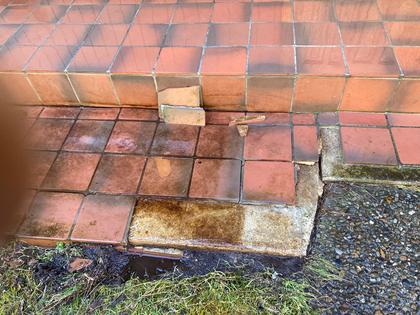Ask the Builder: Installing ceramic tile outdoors
A fellow amateur radio operator reached out to me several days ago. My vanity call sign was coined after my Ask the Builder business. It’s W3ATB. The W3 stands for www for my AsktheBuilder.com website. This operator knew I’d be able to answer his question.
He lives in Coeur d’Alene, Idaho. Thirty years ago, a tile contractor installed ceramic tile outside this man’s house. Some of the tile is protected by a generous roof overhang, but some of it is exposed to every drop of falling rain. Many pieces of this tile are no longer attached to the concrete. This man needed to know how to reattach them so they will not pop off again.
Northern Idaho experiences bitter cold weather in the winter months. It’s not uncommon for the outside temperature to drop below zero for days at a time. My radio friend told me that he guesstimates they have at least ninety days a year where the temperature drops to 27 F or below.
You may or may not know that water expands by about 9% when it freezes. This expansion is so powerful that it can split apart metal water pipes. It can lift entire buildings. This is why foundation footings must be placed deep in the soil where the frost doesn’t penetrate. Knowing this, I think you can see how it’s child’s play for ice to pop tile off a concrete slab.
I had a few back-and-forth emails with the homeowner, as I wanted to get as much background information as I could about the original installation. It turns out the tile contractor had great intentions, but he very likely made a few critical mistakes.
The Tile Council of America (TCA) publishes an in-depth handbook that shares exactly how tile should be installed. If you intend to invest lots of money in ceramic tile in your home, it would be very prudent to purchase this handbook and discover exactly what questions to ask your tile contractor before you sign a contract. You want to probe the depths of his ignorance, as my historical geology professor would exclaim before handing out test papers.
Allow me to share what I would have done if I had been the tile contractor in Idaho all those years ago. I happen to have a very unfair advantage because I had the good fortune back 50 years ago to talk with an old retired concrete mason. He decided to share a secret tip and not take it to his grave. Cement paint. I’ll bet you’ve never heard of that.
Exterior tile is installed on concrete using Portland cement. Modern tile setters and manufacturers call it thinset mortar. In its most basic form, it’s just Portland cement and fine silica sand. Some thinset manufacturers add dry bonding agents to their products to enhance adhesion.
Fortunately, I’m old enough to have seen exterior tile installations on the door stoops of old buildings in Cincinnati. All of this tile had experienced many decades of exposure to harsh winter weather. I remember the tile looking as good as the day it was installed. The tile setters back then didn’t have access to fancy modern thinset. So how did they prevent their tile from popping off the concrete below?
It’s simple. They used cement paint and lots of cement in their mortars. When you add water to Portland cement, you start an irreversible chemical reaction. Countless tiny microscopic crystals start to grow. Think of the worst burr you’ve ever gotten on your pants when hiking. Think of brand new Velcro and how hard it is to pull the two pieces of fabric apart. This is how strong a bond cement can make to things if you do everything right.
The first step is to make sure the concrete substrate is clean and dust-free. This is just common sense, but often it’s in short supply around job sites. Older concrete should be pressure washed to ensure it’s free of all debris. It’s important to realize the tile you use must be rated for your climate. Refer to the TCA handbook for guidance.
If you’re going to use modern thinset, consider adding an additional amount of pure Portland cement to the mix. I’d blend three parts of the bagged thinset to one part Portland cement. You want as many crystals to grow as possible.
The tile needs to be set in a solid bed of mortar. You can’t have any air spaces between the tile and the mortar. Liquid water passes through the grout in between tiles. This water can collect in any void spaces. When it freezes, it will act like a giant hydraulic ram and either lift the tile or crack it.
The secret cement paint is made by mixing clean water with Portland cement. Apply this to the concrete and immediately cover it with the thinset mortar.
Once the grout has cured after 30 days, apply a silane-siloxane water repellent to minimize water getting down into the thinset. Do all of this and your exterior tile should never come up except when the building is demolished.
Subscribe to Tim’s FREE newsletter at AsktheBuilder.com. Tim offers phone coaching calls if you get stuck during a DIY job. Go here: go.askthebuilder.com/coaching
©2024 Tim Carter. Distributed by Tribune Content Agency, LLC.







